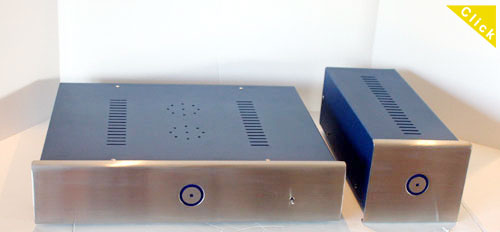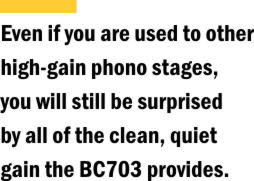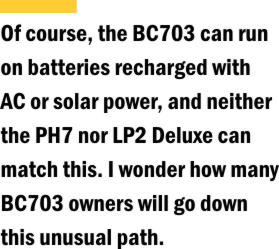Blue Circle Audio • BC703 Phono Stage
he Blue Circle BC703 addresses the primary goals of a phono stage -- providing gain and equalization for the signal from the cartridge -- head on and with great technical success. Tracking of the RIAA EQ curve is within 0.1dB, while gain tops out at a massive 87dB -- more than enough for the infinitesimal signal from the lowest of low-output moving-coil cartridges. The BC703 provides this extraordinary amount of gain without the use of a step-up transformer. To savvy listeners, this means that a transformer's sonic signature -- whatever it might be -- won't be imposed upon the signal. To the technically minded, this also means that loading won't occur with the step-up transformer in series with the cartridge, so the value used will be what the cartridge actually "sees."
Like so many phono stages, the BC703 has a rather unadorned look. The front panel has only the company's logo -- an illuminated blue circle. The separate power supply has the same, the two units connected with a removable umbilical. This no-frills appearance belies the BC703's great flexibility. It accomplishes loading via internal jumpers, with values set at 100, 220, 470 and 1000 ohms. Users can also combine these and thereby fine-tune loading for cartridges that respond to small increments. There is also a custom loading option that's installed at the time the BC703 is ordered. The ubiquitous 47k-ohm setting is omitted for the moving-coil input, because the BC703 has a separate moving-magnet input that is loaded at 47k ohms. Owners are not likely to use the BC703 with a moving-magnet cartridge, yet high-quality phono stages will often include a moving-magnet input so owners can use a step-up transformer into the phono stage. The BC703 provides plenty of gain, so adding a step-up transformer is unnecessary and antithetical to the design goals of the unit. As with loading, gain is adjustable via internal jumpers -- from 61dB to 87dB. Gilbert Yeung, designer and maker of Blue Circle products, is especially proud of the amount of gain the BC703 has available. "As far as I know," he told me, "the BC703 is the only phono stage out there that has over 80dB of gain without a step-up transformer." I know of one other phono stage that produces 80dB of gain. It's from Aurum Acoustics and is an add-on for the company's CDP CD player/preamp. However, it uses a step-up transformer, so it appears that Gilbert has the distinction of providing over 80dB of gain with only active devices. Why so much gain? "Better signal-to-noise ratio," Gilbert contends. Cartridges and phono cables are passive and generate no noise of their own. Thus, at the input jacks of a phono stage, there is only signal (in theory -- EMI and RFI have something to say about this), so, in Gilbert's mind, it is best to put as much gain at this point. "If the input stage doesn't produce enough gain," Gilbert reasons, "the rest of the audio system amplifies the noise from the input stage." In other words, it is best to front-load with gain, putting it at the point where only signal exists, than have all of the components that come after boost the signal along with the noise of the input stage. Inside the BC703 are a few things that may cause some head-scratching. Once you pull the cover off the main chassis, you'll notice something that looks like vanilla frosting coating its underside. This is a spread-on damping compound -- likely some sort of caulk -- and it does the trick, deadening the ringy metal cover. There are prominent banks of capacitors within the main unit and power supply totaling 679,000uF. These feed the signal-carrying circuit and cause the BC703 to continue playing for nearly a full minute after the power has been cut. You'll see a lot of empty space inside the main chassis, along with a male XLR jack. Gilbert included all this for a Supercap upgrade he planned to implement. However, as he thought about it, he came to the conclusion that "Supercaps are still very expensive, so I turned this into a battery power supply instead." This add-on costs $800 and operates in simple fashion: Turn off the power and the unit switches to the batteries; turn it on and it goes back to AC power, which also charges the batteries. But there's more. The BC703 can also be ordered or retrofitted to charge the batteries with solar panels, a $300 option, plus whatever the solar panels cost. This means the BC703 will never have to be plugged in. Gilbert Yeung has just begun offering modifications for the Technics SL-1200-series turntables, including a battery power supply. With such a 'table and a solar-powered BC703, your analog front-end can be completely off the grid. I evaluated the BC703 without the battery or solar options, but I may get some experience with both sometime in 2010. The BC703 has single-ended and balanced outputs, with the former decreasing gain by 6dB and signaling that the BC703 is fully balanced. Other features of note are switches for setting the hot pin of the XLR output for each channel. Another switch lifts the unit's ground, which can be especially useful if connecting your turntable to the BC703 causes a ground loop. There is also an internal rumble filter that will preserve your woofers if your turntable isn't well isolated. As with loading and gain, the rumble filter is engaged via jumpers inside the main chassis. Sometimes it seems as though Gilbert Yeung designs audio gear in his sleep, so vast is his product line, and so much does it continue to grow. Gilbert makes four other phono stages. The BC707 ($2295) and BC709 ($1295) come in single chassis. The Fon Lo Thingee ($349 or $549 depending power supply) and Fon Lo Thingee MC ($378 or $578 depending power supply) would never make it through airport security because they resemble explosive devices. Gilbert uses ABS pipe to house some of his products in order to keep their cost down, and he does pass that along to customers. Some choices, some music f all the adjustments you will make when using the BC703, the one that has the greatest impact is the gain setting, though for the sake of convenience and not better sonic performance. If you have a low-output moving-coil cartridge, you always have to ensure that any phono stage you use has adequate gain in order to re-create some semblance of dynamic range. Even at its lowest setting, 61dB, the BC703 provides this, and higher settings don't alter the sonic outcome. Thus, you will choose gain based on how loud you want your records to be at any given volume setting, likely choosing a gain setting that puts the BC703's output with your cartridge near the output of your CD player. This will save you from being blasted when you switch from analog to digital and don't remember to adjust for the volume difference, and it makes easy A/B comparisons between CDs and LPs possible (for those of us anal enough to do these).
There are two ways to describe my interest in classical music: modest and focused. I am not one to own multiple versions of every Mahler symphony -- or any Mahler symphony. Instead, I have specific areas of interest. These include Bach and Chopin keyboard works, especially performed by some of the more idiosyncratic pianists, certain modern orchestral and choral pieces, and a few chestnuts that appeal to me probably because I've heard them so many times. In this last group falls Also Sprach Zarathrustra, that war-horse from concert hall and screen. I have been fortunate enough to find two copies of the Herbert von Karajan/Michel Schwalbé Zarathrustra on DG [Deutsche Grammophon 2530 402] at our local library for next to nothing. Speakers Corner has reissued this LP, a sign of its musical and sonic worth. The opening had thundering power and presence through the BC703, and instruments in the farthest corners of the concert hall never withdrew into the LP's noise floor. Pressed in Germany, DG LPs are generally very quiet, but it still takes a special analog system to dig the tiniest details from them. My TW-Acustic turntable and Dynavector cartridge were fully up to the task with the BC703. The BC703 can, therefore, handle music's delicacy, but its personality is more defined by immediacy and forcefulness. Music jumps from the BC703 without belying the natural sense of ease for which analog is so well known. This begins with the bass, which is powerful, variegated and well defined. A few months ago I received a test pressing of the Music Matters 45rpm double-LP set of trombone master Curtis Fuller's The Opener [Blue Note/Music Matters MMBLP-1567]. This will be available in January 2010, and it's one of the unheralded Blue Note titles that cognoscenti like Joe Harley and Ron Rambach of Music Matters know well because of the important music it captures. "Lizzy's Bounce" showed off what the BC703 does particularly well. The upright bass was well focused and seemed especially athletic and potent for an instrument recorded 50 years ago. The piano followed, sounding tinkly and brisk. The BC703 separated the instrumental lines with ease, adding nothing while revealing everything. And this leads to one of the most interesting things about the BC703 -- how little it sounds like other Blue Circle products I've heard. Gilbert Yeung's BC204 and BC208 amps, for instance, are hybrid designs, and there is a tubey richness to their sound. The BC703, in contrast, lacks the tubes and the richness. It stresses clarity and vividness, imparting the sense that you're hearing everything your turntable and cartridge have to offer, even if the perspective is a bit more up front than it might be with another phono stage. There is no billowy warmth through the midrange, no forgiving softness in the treble. The BC703 isn't ruthless, but neither is it merciful. It displays an extreme amount of detail and extreme dynamic agility. With well-recorded contemporary LPs, like Beck's Modern Guilt [Innerscope Records B001163001], it's fast into and out of each note, and with a highly layered, ambient, warm-sounding LP like Beck's Sea Change [Mobile Fidelity MFSL 2-308], the BC703 exposes the layers and ambience without exacerbating the warmth. It changes with each recording -- the very definition of high fidelity. ARC, BC and Lamm
Sonically speaking, the BC703 resides at one extreme in this phono-stage trio -- where low noise, dynamic prowess, and overall vividness rule the day. The Audio Research PH7 is at the other extreme, where a large, billowy soundstage and tonal sweetness dwell. In between, almost perfectly, is the Lamm LP2 Deluxe, which isn't as attention-grabbing as the BC703 or PH7, portraying music in a more naturally rendered way. The LP2 Deluxe has solid image outlines and a physical treble that gives brass great punch and blat. In the bass, it has greater power and weight than the PH7, which has the more prominent midbass. The BC703 pretty much equaled the LP2 Deluxe's low-end abilities, sounding a touch less weighty overall. Sheer midrange beauty was the domain of the PH7, with the Blue Circle and Lamm phono stages offering a more straight-ahead, unadorned presentation. In terms of dynamics, the BC703 cut loose without any restraint or sense of strain. The PH7 and LP2 Deluxe displayed more-than-adequate dynamics, but they didn't dig as deeply to extract low-level detail or let loose with the same speed and unfettered abandon. None of these phono stages would be considered noisy, but the BC703 and LP2 Deluxe are the quietest of the three. To answer the question that may be on your mind: I honestly can't name a winner here. Or, to put it another way, there are three winners here. Perhaps it's best to make a recommendation based on the cartridge with which each of these phono stages would perform best. With a Koetsu or Benz, the Blue Circle or Lamm phono stage would let the sheer beauty -- in the midrange and otherwise -- shine through. With a fleet and detailed Lyra or Clearaudio, the Audio Research PH7 would add a touch of sweetness without turning the presentation cloying, and it would help portray the music in a spacious way. With a Dynavector, which is what I use, you can achieve a pleasing balance with any of these phono stages, although the outcome won't sound identical by any means. Final thoughts o often the first consideration of phono-stage shoppers has nothing to do with sound quality. Rather, they must be sure that a particular model will work optimally -- in terms of gain and loading -- with their chosen cartridge. With this in mind, I can confidently say that the BC703 is about as universal a phono stage as exists here and now. Its loading affords tremendous flexibility, and its enormous amount of gain will ensure that no cartridge will tax its output capabilities. It has an interesting upgrade path, one that deals directly with the vagaries of the power you feed to it, and it's built by someone whose products often represent unique solutions, technical and sonic, to meaningful audio issues. Because of all the products Gilbert Yeung makes -- and
introduces anew each year -- some of his best efforts are overlooked in favor of
competition that has achieved greater prominence in the market, whether it's deserved or
not. If you plan to spend a sizeable sum of money on a phono stage, the BC703 deserves
serious consideration and a long, careful listen.
|


 All that gain is a good
starting point for talking about the BC703's sound as well, because it provides the music
with a foundation of low noise and wide dynamic range. The BC703 is very quiet and massively
dynamic. From the lowest-levels of orchestral music to full-on rock, it reveals the most
minute musically significant details in a tonally true, spatially correct manner. It also
cuts loose with quick-paced, soaring large-scale dynamics that are reminiscent of CD. Even
if you are used to other high-gain phono stages, you will still be surprised by all of the
clean, quiet gain the BC703 provides.
All that gain is a good
starting point for talking about the BC703's sound as well, because it provides the music
with a foundation of low noise and wide dynamic range. The BC703 is very quiet and massively
dynamic. From the lowest-levels of orchestral music to full-on rock, it reveals the most
minute musically significant details in a tonally true, spatially correct manner. It also
cuts loose with quick-paced, soaring large-scale dynamics that are reminiscent of CD. Even
if you are used to other high-gain phono stages, you will still be surprised by all of the
clean, quiet gain the BC703 provides. t the same
time I was listening to the BC703, I also had available a pair of phono stages that are
direct competition for it: the Audio Research PH7 ($5995) and Lamm LP2 Deluxe ($7290).
There are ample similarities and differences among these three phono stages. The PH7 and
LP2 Deluxe are both single-chassis tubed units that feature tube power-supply
rectification. Both offer a more conventional amount of gain than the BC703 -- 58dB in
both cases -- and until the introduction of the Audio Research Reference Phono 2, both
resided at the top of their makers' phono-stage lineup. The LP2 Deluxe has a heavy damping
plate affixed to the bottom of its chassis to reduce the sonic effects of mechanical
vibration. It also uses a step-up transformer. The PH7 has remote-control-adjustable
loading, among other user niceties, and, like the BC703, it derives its gain from active
devices only. Of course, the BC703 can run on batteries recharged with AC or solar power,
and neither the PH7 nor LP2 Deluxe can match this. I wonder how many BC703 owners will go
down this unusual path.
t the same
time I was listening to the BC703, I also had available a pair of phono stages that are
direct competition for it: the Audio Research PH7 ($5995) and Lamm LP2 Deluxe ($7290).
There are ample similarities and differences among these three phono stages. The PH7 and
LP2 Deluxe are both single-chassis tubed units that feature tube power-supply
rectification. Both offer a more conventional amount of gain than the BC703 -- 58dB in
both cases -- and until the introduction of the Audio Research Reference Phono 2, both
resided at the top of their makers' phono-stage lineup. The LP2 Deluxe has a heavy damping
plate affixed to the bottom of its chassis to reduce the sonic effects of mechanical
vibration. It also uses a step-up transformer. The PH7 has remote-control-adjustable
loading, among other user niceties, and, like the BC703, it derives its gain from active
devices only. Of course, the BC703 can run on batteries recharged with AC or solar power,
and neither the PH7 nor LP2 Deluxe can match this. I wonder how many BC703 owners will go
down this unusual path.